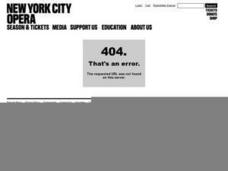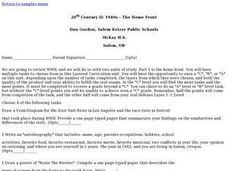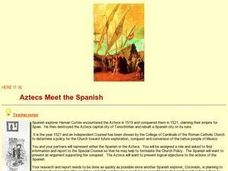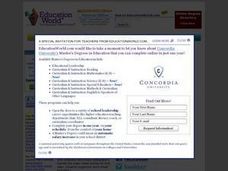Curated OER
Constrating Cinderellas/ Connecting LA Cenerentola
Students contrast the traditional Cinderella character with a modern, independent and socially conscious Cinderella. To activate prior knowledge by eliciting from the students some of the familiar story elements of the traditional...
Curated OER
20th Century II: 1940s - The Home Front
Students complete a creative project. They create a collage of 40's fashions. Provide a key for each picture and a brief description of the fashion or fad that includes some background on the group(s) who wore these styles.This is one of...
Curated OER
Christmas in Mexico
Students identify how Christmas holidays are celebrated in Mexico, compare Mexican holidays with U.S. holidays, and learn Mexican customs. Lesson includes many downloadable activities to try with students.
Curated OER
Woman Holding Plum Blossoms
Students contrast and compare the definition of beauty in Tang dynasty China with that of America today in this high school Social Studies lesson. The lesson concludes with a small group activity.
Curated OER
People Who Make A Difference: American Heroes
Students think about the characteristics of a hero so they can later evaluate which historical figures on the heroes chart meet the criteria.
Curated OER
Aztecs Meet the Spanish
Students simulate an Independent Counsel to represent the Spanish and the Aztecs to formulate a policy for the Roman Catholic Church in 1527. They conduct research, graph the similarities and differences, create a poster, and write a...
Curated OER
Early English Settlement
Fifth graders encounter the TCI History Alive Assessment. Create a rubric together with other students. Use graphic organizers to brainstorm challenges that one would face attending school in a foreign country.
Curated OER
Working on the Slant
Compare and contrast a major news story from various newspapers. How does the perspective change? Are certain things included in some of the stories and left out of others? Have pupils complete a graphic organizer to compare how...
Curated OER
Fractured Fairy Tales
Students use familiar characters, plots, and settings from traditional fairy tales to create "fractured" versions, while experimenting with satire, irony and parody. A fractured fairy tale is designed to be humorous by changing the story...
Curated OER
Captive Breeding and Species Survival
Learners research and assess programs that strive to preserve biodiversity, such as captive-breeding programs and species-survival plans adopted by zoos, aquariums, and other institutions.
Curated OER
A Comparison of Dunbar and Central High In Little Rock, Arkansas
Young sociologists analyze the needs of white and black students. They discuss how Central and Dunbar High Schools are alike and different before 1957. They write an essay comparing the two schools.
Curated OER
Critical Listening: Music Vocabulary
The school band or orchestra analyzes their own performance after exploring musical terminology. They listen to a classical piece and describe it using only words. They look up musical terminology and then use those words to compare and...
Curated OER
Cloudy With a Chance of Meatballs
Fourth graders participate in a play to work on seeing events from a different perspective. Some of them are reporters, some cameramen and women, and others are interviewed. They put themselves in the shoes of the people in the book...
Curated OER
Our Town
With the songs "My Hometown" by Bruce Springsteen and "Allentown" by Billy Joel, learners examine external versus internal conflict. When they have finished the first part of the lesson, they create their own poem (or song) about the...
Curated OER
Our Town: Using Song Lyrics in the Classroom
Bruce Springsteen’s “My Hometown” and Billy Joel’s “Allentown” motivate young lyricists to craft poems about their own home town. Groups compare the two songs, identifying details, symbols, and conflicts. Individuals then picture a place...
Virginia Department of Education
Inductive and Deductive Reasoning
Introduce pupils to the two types of reasoning, inductive and deductive. Classmates work in pairs or small groups to learn the difference between the two and apply these reasonings to develop valid conclusions.
Curated OER
Living-Nonliving
Students determine that environments have living and nonliving parts. They discuss what makes something a living thing and something a nonliving thing. They make a chart and list characteristics of living things and nonliving things.
Curated OER
From Graphic Organizer to Composition - Grade Six
How does one use a graphic organizer to plan writing? Introduce your writers to different types of graphic organizers by dividing the class into groups and assigning each group a particular organizer. Then, as they research chocolate...
Virginia Department of Education
Properties of Quadrilaterals
What type of quadrilateral is that? Discover the difference between the types of quadrilaterals. Small groups investigate types of quadrilaterals using geometry software to find their properties. To keep track of the different...
Curated OER
Soils
Students apply knowledge of soil, environmental impacts, economics, multiple human demands, and use given data for a proposed scenario in making land use decisions. They debate land use issues and/or scenarios and discuss a case study.
Curated OER
The Outsiders Debate Project
Eighth graders read the book The Outsiders for understanding. They develop arguments, with support, for six assigned debate points. They write a position paper based on six debate points. The dress up as a character in the book and...
Virginia Department of Education
Logic and Conditional Statements
If there is a conditional statement, then there is a hypothesis and conclusion. Pupils learn how to identify the parts of conditional statements. Class members continue to work with conditional statements and rewrite them in their many...
Curated OER
Life Before Electricity
Students describe life before the introduction of electricity, and debate the implications of the introduction of electricity on society.
Curated OER
This Land is Your Land - Travel Posters
Eleventh graders compile a list of places in the United States where they have either traveled or where their relatives or friends live. They collect travel posters, brochures, postcards, and maps from their region of the United States.























